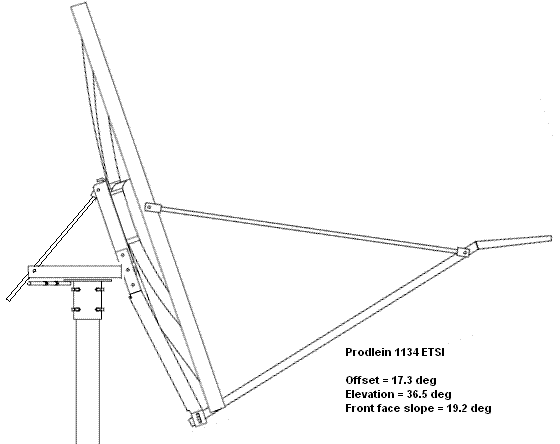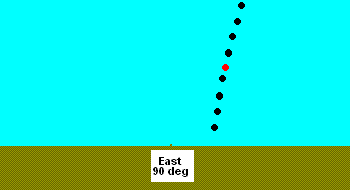|
Africa satellite service providers Dish pointing in Southern Africa |
Installation of an iDirect VSAT dish in Sudan, working to PAS 10 satellite at 68.5 deg east longitude, using Prodelin 1134 dish.
For Darfur 12 deg 55 min North latitude, 23 deg 29 min East longitude and PAS10 satellite at 68.5 deg east orbit longitude the pointing angles are:-
Azimuth:
Azimuth = 102.8 deg (a little to the right of due east with a magnetic compass)
Elevation:
Beam elevation = 36.5 deg Note that the Prodelin 1134 dish is a special high polarisation purity version with a longer feed arm than normal. The offset angle is 17.3 deg so this means that if the dish front face is vertical the beam elevation is 17.3 deg. You need to set 36.5 deg beam elevation so the top of your dish must be tilted backwards so that the front face slopes backwards at 19.2 deg. If you are using an inclinometer put it against a plank of wood rested up/down across the front of the dish.

I have made this image to look exactly like what the dish should look like at 36.5 deg beam elevation angle.
Note the front rim of the dish should be flat to less than 1.5mm. If you put fishing line tight up/down and across the threads should just touch. It may help to remove any alignment screw attaching the dish to the feed arm (at the bottom). Then push very hard forwards on the bottom ends of the spine strips while tightening the upper and lower of the three visible bolts where the spine strips attach at the back, on both sides. You will then hopefully find the hole in the feed arm is perhaps 3mm forwards of the hole in the lower edge of the dish. The Prodelin 1134 design is rather flimsy and tends to distort easily due to weight of the feed assembly. The insertion of a bolt here must not push the lower dish edge backwards at all.
Polarisation angle:
This is the rotation of the feed while you face in the direction towards the satellite. Start with the feed assembly upright and then turn anticlockwise 72 deg or turn it clockwise by 18 deg. If you knew for certain what nominal polarisation is required. For example if you have been told to receive nominal vertical polarisation, with the LNB receive waveguide like this :
![]()
This is your starting position. Then turn it anticlockwise 72 deg.
If there is uncertainty then you will need to try both polarisations, 72 deg anticlockwise and 18 deg clockwise, facing the satellite. If you have scale, a magnifying glass may help. Note that the + / - signs on scale may be reversed. Follow my "facing towards satellite" rule. Clockwise is positive. You can also put an inclinometer across the back of the BUC to set the polarisation angle. It needs to be accurate to 1 deg and the hub may have to talk to you while you turn it in microscopic movements to null out the transmit interference. When you swing the dish you should see the level shown increase and decrease. Move it smoothly and slowly while watching the meter/display. If you miss the satellite on the first swing rotate the feed 90 deg and try again. Then try the elevation angle 1 deg up and try again with both polarisations. Once you find any satellite mark the angles.The next satellite in the orbit will be directly above and below that one. If you don't see anything at all, check the LNB power is ON. The centre pin of the F connectors should stick out 2mm and not get pushed back into the cable when you screw it up.

View of the sky looking to the east, where the sun rises.. Note that the line of the geostationary orbit satellites is tilted, approx 18 deg to the right - the same as the required polarisation angle. Tilt your head to make the line horizontal and you can see that the opposite polarisation is tilted 72 deg to the left.
Once you have found the satellite make a bit error rate (BER) quality measurement or some other quality measurement like Eb/No and then turn the lower elevation nut 1/6th of a turn, make another measurement and repeat several times till you go through the peak, then wind back to the exact centre. Then do the azimuth. Loosen the two nuts approx 6mm either side of the metal and gently swing the dish against both nuts alternately ten times, till you have two exactly equal degraded quality measurements either side. Move the nuts till the degraded qualities are the same. Then put the metal in the middle and tighten each nut by the same number of turns and flats till it is tight. It is now exactly in the middle. Tighten up the general clamping arrangements and repeat the elevation adjustment last, since tightening the main bolts will raise the elevation slightly. It may take 1 hour to do all the fine adjustments.
The reason for such a fuss over getting the pointing perfect is that the transmit beam width is less than the receive beam width so if is no good getting the receive performance good enough. You need to get to the exact centre so theta the transmit beam, which is narrower is properly pointed.
Good luck. Best regards, Eric.
|
► Page created 23 March 2006, amended 16 May 2016, 6 April 2019 HTML5 All pages on this satsig.net web site are Copyright Satellite Signals Limited © 2005 all rights reserved. |